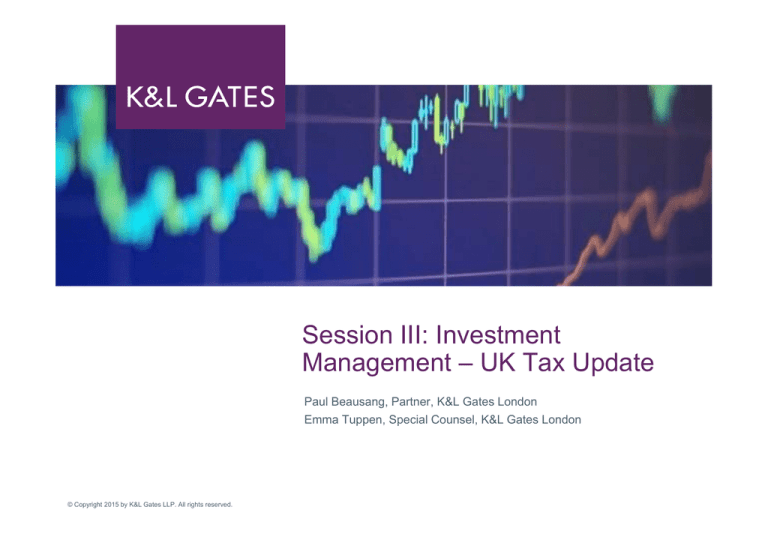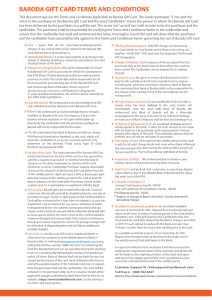
Session III: Investment
Management – UK Tax Update
Paul Beausang, Partner, K&L Gates London
Emma Tuppen, Special Counsel, K&L Gates London
© Copyright 2015 by K&L Gates LLP. All rights reserved.
UK Tax Updates
Diverted Profits Tax
Disguised Investment Management Fees
BEPS
Diverted Profits Tax – introduction
Announced in the 2014 Autumn Statement
“A new tax to counter the use of aggressive tax
planning techniques used by multinational
enterprises to divert profits from the UK”
Modest predicted yield
Came into force on 1 April 2015
Criticisms
DPT – headline points
The rate of DPT is 25% (CT rate is 20%)
DPT does not apply to SMEs
Financing arrangements are excluded
Some “safe harbours”
No self-assessment required but notification
requirement to HMRC
No clearance procedure but possibility of a written
opinion
Two main circumstances in which DPT is intended to
apply
Circumstance 1: the “section 80 charge”
“Involvement of entities or transactions lacking
economic substance”
UK company (or PE) erodes its tax base by
transacting with an affiliate in circumstances where
the arrangement or affiliate lacks economic
substance
Even if the arrangement is on arm’s-length terms
Section 80 charge — example
Company A
Parent
(1) injection of capital
C
(UK company)
(3)
fee for P&M
P
(tax haven)
(2) acquisition of P&M
When does the section 80 charge apply?
Provision between
UKCo (C) and
another P?
No
Yes
Are C and P
affiliated?
No
Yes
Does the provision result in
an “effective tax mismatch
outcome” (which does not
arise from an “excepted loan
relationship outcome” or
other excepted payment)?
No
Yes
Is the
“insufficient
economic
substance
condition” met?
DPT
No
No DPT
Assume C and P are not SMEs
Section 80 charge — example
Company A
Parent
(1) injection of capital
C
(UK company)
Material provision?
(3)
fee for P&M
P
(tax haven)
(2) acquisition of P&M
Section 80 charge — example
Company A
Parent
(1) injection of capital
C
(UK company)
Material provision?
C and P affiliated?
(3)
fee for P&M
P
(tax haven)
(2) acquisition of P&M
Section 80 charge — example
Company A
Parent
(1) injection of capital
C
(UK company)
Material provision?
C and P affiliated?
Effective tax mismatch outcome?
(3)
fee for P&M
P
(tax haven)
(2) acquisition of P&M
Section 80 charge — example
Company A
Parent
(1) injection of capital
C
(UK company)
(3)
fee for P&M
Material provision?
C and P affiliated?
Effective tax mismatch outcome?
Insufficient economic substance condition?
P
(tax haven)
(2) acquisition of P&M
Circumstance 2: the ‘section 86 charge’
‘Non-UK company avoiding a UK-taxable presence’
A foreign company carries on a business in
connection with which there is activity carried on in
the UK
The foreign company’s affairs are designed in such a
way as to avoid a UK PE arising
Section 86 charge — example
Company A
Parent
B concludes
contracts
Company B
(EU 1)
Royalties for IP
(no WHT)
Payment for
services
Company E
(UK company)
E provides marketing and customer support services
Company C
(EU 2)
Royalties for IP
(no WHT)
Company D
(holding IP)
(EU/low tax
jurisdiction)
When does the section 86 charge apply?
Non-UK Co
(N) carrying
on trade?
Yes
Person (the
“avoided PE”)
carrying on
activity in UK
connected to
trade?
Yes
Reasonable to
assume that N is
avoiding carrying
on trade in the
UK?
Yes
Sales more
than £10m
and/or
expenses
more than
£1m?
Yes
Avoidance
motive?
No
No
No
No
Yes
DPT
No
Mismatch
condition met?
Yes
No
No DPT
Assume no SMEs
Section 86 charge — example
Company A
Parent
B concludes
contracts
Company B
(EU 1)
Royalties for IP
(no WHT)
Payment for
services
Company C
(EU 2)
•
Company E
(UK company)
E provides marketing and customer support services
Royalties for IP
(no WHT)
Company D
(holding IP)
(EU/low tax
jurisdiction)
Non-resident carrying on trade?
Section 86 charge — example
Company A
Parent
B concludes
contracts
Company B
(EU 1)
Royalties for IP
(no WHT)
payment for
services
Company E
(UK company)
E provides marketing and customer support services
Company C
(EU 2)
Royalties for IP
(no WHT)
Company D
(holding IP)
(EU/low tax
jurisdiction)
•
Non-resident carrying on trade?
•
“Avoided PE” carrying on activity in UK?
Section 86 charge — example
Company A
Parent
B concludes
contracts
Company B
(EU 1)
Royalties for IP
(no WHT)
payment for
services
Company E
(UK company)
E provides marketing and customer support services
Company C
(EU 2)
Royalties for IP
(no WHT)
Company D
(holding IP)
(EU/low tax
jurisdiction)
•
Non-resident carrying on trade?
•
“Avoided PE” carrying on activity in UK?
•
Reasonable assumption that PE avoided?
Section 86 charge — example
Company A
Parent
B concludes
contracts
Company B
(EU 1)
Royalties for IP
(no WHT)
payment for
services
Company E
(UK company)
E provides marketing and customer support services
Company C
(EU 2)
Royalties for IP
(no WHT)
Company D
(holding IP)
(EU/low tax
jurisdiction)
•
Non-resident carrying on trade?
•
“Avoided PE” carrying on activity in UK?
•
Reasonable assumption that PE avoided?
•
Sales > £10m and expenses > £1m?
Section 86 charge — example
Company A
Parent
B concludes
contracts
Company B
(EU 1)
Royalties for IP
(no WHT)
payment for
services
Company E
(UK company)
E provides marketing and customer support services
Company C
(EU 2)
Royalties for IP
(no WHT)
Company D
(holding IP)
(EU/low tax
jurisdiction)
•
Non-resident carrying on trade?
•
“Avoided PE” carrying on activity in UK?
•
Reasonable assumption that PE avoided?
•
Sales > £10m and expenses > £1m?
•
Avoidance motive or mismatch condition?
DPT — investment management
offshore funds
(low tax jurisdiction)
Investment management
services
ManCo
(low tax jurisdiction)
Investment
management
services
UKCo
Conclusions
DPT now in force
Wide in scope – many sectors need to consider
Uncertainty in application – untaxed by concession?
Time and cost implications
Disguised Investment Management Fees
Recent Change – quickly introduced
First announced December 14, legislated with effect from April 15
Targeted at “GPS streaming” or Gross Payment Schemes
Mischief is individuals getting CGT treatment (max 28%) of
guaranteed/annual running fees
Such fees would ordinarily be liable to income tax at 45 – 47% for
most individual managers
Original scope – very wide, few exceptions
Unintended consequences caught many normal carry
arrangements
Further exceptions/safe-harbours added
Nature of the Charge
Anti-avoidance – very broad definitions
Applies to “Disguised Fees”
Paid to “individuals” – natural persons only
Paid a “management fee, directly or indirectly”
Any sums paid/in kind/loans/back to back arrangements etc.
For carrying out “investment management services”
Includes fund raising, investing and even research and analysis
On behalf of “Investment Schemes”
Means a collective investment scheme per s235 FSMA 2000, or an investment trust
(as defined in tax legislation – s1158 CTA 2010)
Where at least one partnership is included in the arrangements
Individual doesn’t need to be a partner of that partnership
And the individual receives a management fee that is “untaxed”
Means not charged to income tax, either as employment income or as trading
income
Example of GP LP Planning
Annual Fees
Paid by Fund LP to GP LP
Some paid to fund executives – so
Payment to individuals
Management fee paid
Investment management services
Investment schemes
Arrangement includes partnership
Safe Harbours
Charging rules are, therefore very wide
‘management fee’ = ‘if it’s not out, it’s in!’
Safe harbours
Repayment of investment
Return to individual of its original capital/loan to the investment scheme
Co-investment return
Needs to be arm’s length, so comparable to external investors’ returns
Revenue guidance specifically looks for additional guaranteed sums
Carried interest
Sums paid over and above a hurdle – minimum 6% hurdle rate
‘profit-related return’
Must be “significant risk” return will not be paid, and sum must vary proportionately to the profits
“Profits” can be calculated on fund as a whole OR deal-by-deal basis
Returns for external investors are determined in a similar fashion
Anti-avoidance – New Approach
From Shakespeare to Schwarznegger!
Withdrawal of group relief
3—
(1) Where in the case of a transaction (“the relevant transaction”) that is exempt from charge by virtue of paragraph 1 (group relief)—
(a) the purchaser ceases to be a member of the same group as the vendor—
(i) before the end of the period of three years beginning with the effective date of the transaction, or
(ii) in pursuance of, or in connection with, arrangements made before the end of that period,
and
(b) at the time the purchaser ceases to be a member of the same group as the vendor (“the relevant time”), it or a relevant associated company holds a chargeable interest—
(i) that was acquired by the purchaser under the relevant transaction, or
(ii) that is derived from a chargeable interest so acquired,
and that has not subsequently been acquired at market value under a chargeable transaction for which group relief was available but was not claimed,
group relief in relation to the relevant transaction, or an appropriate proportion of it, is withdrawn and tax is chargeable in accordance with this paragraph.
[(2) The amount chargeable is the tax that would have been chargeable in respect of the relevant transaction but for group relief if the chargeable consideration for that transaction had been an amount equal to—
(a) the market value of the subject-matter of the transaction, and
(b) if the acquisition was the grant of a lease at a rent, that rent,
or, as the case may be, an appropriate proportion of the tax that would have been so chargeable.]1
(3) In sub-paragraphs (1) and (2) “an appropriate proportion” means an appropriate proportion having regard to the subject matter of the relevant transaction and what is held at the relevant time by the transferee company
or,
as the case may be, by that company and its relevant associated companies.
(4) In this paragraph—
“arrangements” includes any scheme, agreement or understanding, whether or not legally enforceable; and
“relevant associated company”, in relation to the purchaser, means a company that—
(a) is a member of the same group as the purchaser immediately before the purchaser ceases to be a member of the same group as the vendor, and
(b) ceases to be a member of the same group as the vendor in consequence of the purchaser so ceasing.
(5) This paragraph has effect subject to [paragraphs 4 and 4ZA]3 (cases in which group relief not withdrawn) [and paragraph 4A (withdrawal of group relief in certain cases involving successive transactions)]2.
Cases in which group relief not withdrawn
4—
(1) Group relief is not withdrawn under paragraph 3 in the following cases.
(2), (3) …3
(4) The second case is where the purchaser ceases to be a member of the same group as the vendor by reason of anything done for the purposes of, or in the course of, winding up the vendor or another company that
is above the vendor in the group structure.
(5) For [the purposes of [sub-paragraph (4)]3]1 a company is “above” the vendor in the group structure if the vendor, or another company that is above the vendor in the group structure, is a 75% subsidiary of the company.
(6) The third case is where—
(a) the purchaser ceases to be a member of the same group as the vendor as a result of an acquisition of shares by another company (“the acquiring company”) in relation to which—
(i) section 75 of the Finance Act 1986 (c 41) applies (stamp duty: acquisition relief), and
(ii) the conditions for relief under that section are met,
and
(b) the purchaser is immediately after that acquisition a member of the same group as the acquiring company.
[(6A) The fourth case is where—
(a) the purchaser ceases to be a member of the same group as the vendor as a result of the transfer of the whole or part of the vendor's business to another company (“the acquiring company”) in relation to which—
(i) section 96 of the Finance Act 1997 applies (stamp duty relief: demutualisation of insurance companies), and
(ii) the conditions for relief under that section are met, and
(b) the purchaser is immediately after that transfer a member of the same group as the acquiring company.]2
(7) But if in a case within sub-paragraph (6) [or (6A)]2—
(a) the purchaser ceases to be a member of the same group as the acquiring company—
(i) before the end of the period of three years beginning with the effective date of the relevant transaction, or
(ii) in pursuance of, or in connection with, arrangements made before the end of that period,
and
(b) at the time the purchaser ceases to be a member of the same group as the acquiring company, it or a relevant associated company holds a chargeable interest—
(i) that was acquired by the purchaser under the relevant transaction, or
(ii) that is derived from an interest so acquired,
and that has not subsequently been acquired at market value under a chargeable transaction for which group relief was available but was not claimed,
the provisions of this Part relating to group relief apply as if the purchaser had then ceased to be a member of the same group as the vendor.
(8) In sub-paragraph (7)—
“arrangements” includes any scheme, agreement or understanding, whether or not legally enforceable; and
“relevant associated company”, in relation to the purchaser, means a company that is a member of the same group as the purchaser that ceases to be a member of the same group as the acquiring company in consequence
of the purchaser so ceasing.
[Group relief not withdrawn where vendor leaves group
4ZA—
(1) Group relief is not withdrawn under paragraph 3 where the purchaser ceases to be a member of the same group as the vendor because the vendor leaves the group.
(2) The vendor is regarded as leaving the group if the companies cease to be members of the same group by reason of a transaction relating to shares in—
(a) the vendor, or
(b) another company that—
(i) is above the vendor in the group structure, and
(ii) as a result of the transaction ceases to be a member of the same group as the purchaser.
(3) For the purpose of sub-paragraph (2) a company is “above” the vendor in the group structure if the vendor, or another company that is above the vendor in the group structure, is a 75% subsidiary of the company.
(4) But if there is a change in the control of the purchaser after the vendor leaves the group, paragraphs 3, 4(6) and (7), 5 and 6 have effect as if the purchaser had then ceased to be a member of the same group as the
vendor (but see sub-paragraph (7)).
(5) For the purposes of this paragraph there is a change in the control of the purchaser if—
(a) a person who controls the purchaser (alone or with others) ceases to do so,
(b) a person obtains control of the purchaser (alone or with others), or
(c) the purchaser is wound up.
(6) For the purposes of sub-paragraph (5) a person does not control, or obtain control of, the purchaser if that person is under the control of another person or other persons.
(7) Sub-paragraph (4) does not apply where—
(a) there is a change in the control of the purchaser because a loan creditor (within the meaning [given by section 453 of the Corporation Tax Act 2010]2) obtains control of, or ceases to control, the purchaser, and
(b) the other persons who controlled the purchaser before that change continue to do so.
(8) In this paragraph references to “control” shall be interpreted in accordance with [sections 450 and 451 of the Corporation Tax Act 2010]2 (subject to sub-paragraph (6)).]1
“In determining whether [main charging
section] applies in relation to an
individual, no regard is to be had to any
arrangements the main purpose, or one
of the main purposes, of which is to
secure that that section does not apply in
relation to the individual…”
Anti-avoidance — Continued
Previously, UK used highly complex, detailed and very
technical anti-avoidance legislative drafting.
Now – anti-avoidance much shorter, less technical –
principles-based approach
BEPS Update
BEPS – Action 7 (Prevention of artificial avoidance of PEs)
Progressing – latest discussion draft attacks commissionaire arrangements
Not only concludes contracts, but negotiates material parts
Anti-fragmentation rule – attacks cases where business sub-divided
Limit relief where discrete activities qualify for specific PE exemption (similar concept to
DPT)
Attribution of Profit Rules – awaiting developments on other BEPS Actions
BEPS – Action 6 (Prevent treaty abuse)
Limitation of benefits clause for the OECD model tax treaty
No single treaty approach for CIVs – conclusion is system works albeit is onerous
Pension funds to be given ability to claim relief
Principle Purposes Test (anti-conduit rule) – tax authority discretion to grant relief




